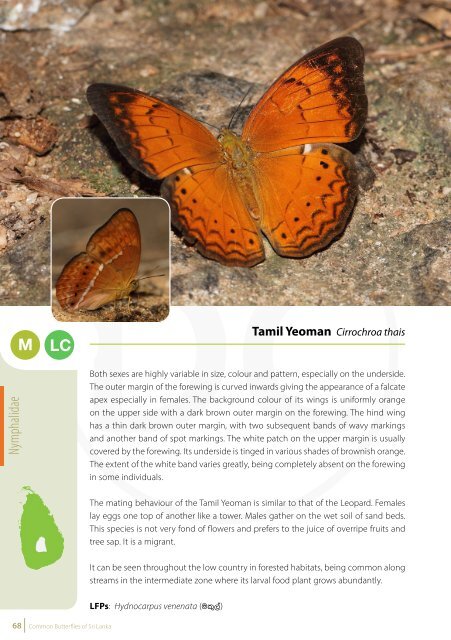Common Butterflies of Sri Lanka
Common Butterflies of Sri Lanka
Common Butterflies of Sri Lanka
Create successful ePaper yourself
Turn your PDF publications into a flip-book with our unique Google optimized e-Paper software.
M<br />
LC<br />
Tamil Yeoman Cirrochroa thais<br />
Indian Fritillary Argynnis hyperbius<br />
M<br />
EN<br />
Nymphalidae<br />
Both sexes are highly variable in size, colour and pattern, especially on the underside.<br />
The outer margin <strong>of</strong> the forewing is curved inwards giving the appearance <strong>of</strong> a falcate<br />
apex especially in females. The background colour <strong>of</strong> its wings is uniformly orange<br />
on the upper side with a dark brown outer margin on the forewing. The hind wing<br />
has a thin dark brown outer margin, with two subsequent bands <strong>of</strong> wavy markings<br />
and another band <strong>of</strong> spot markings. The white patch on the upper margin is usually<br />
covered by the forewing. Its underside is tinged in various shades <strong>of</strong> brownish orange.<br />
The extent <strong>of</strong> the white band varies greatly, being completely absent on the forewing<br />
in some individuals.<br />
The mating behaviour <strong>of</strong> the Tamil Yeoman is similar to that <strong>of</strong> the Leopard. Females<br />
lay eggs one top <strong>of</strong> another like a tower. Males gather on the wet soil <strong>of</strong> sand beds.<br />
This species is not very fond <strong>of</strong> flowers and prefers to the juice <strong>of</strong> overripe fruits and<br />
tree sap. It is a migrant.<br />
The male resembles a Leopard on the upper side, except that it has two rows <strong>of</strong><br />
bluish streaks on the black-coloured outer margin <strong>of</strong> its hind wing. The basal part <strong>of</strong><br />
forewing is rosy red on the underside with black markings. The apical area is marked in<br />
yellowish brown, greenish brown and white. The entire hind wing is marked in these<br />
three colours, together with a few black lines. The forewing is a rosy red at the basal<br />
end and bluish grey on the distal end <strong>of</strong> the upper side in females. It has a sub-apical<br />
white band and is scattered with black patches. The hind wing is similar to that <strong>of</strong> the<br />
male. The underside looks like that <strong>of</strong> the male except for the white sub-apical band.<br />
It is quite a fast flier and prefers the hot hours <strong>of</strong> the day. It is easily disturbed but<br />
returns to the same place after a while. Males are fond <strong>of</strong> mud puddling. Females<br />
descend to the ground, camouflaging themselves among the grasses in closed wing<br />
position. They also come to the ground to lay eggs on and around their herbaceous<br />
LFPs. Both sexes bask while settling on the ground.<br />
Male<br />
Male<br />
Nymphalidae<br />
It can be seen throughout the low country in forested habitats, being common along<br />
streams in the intermediate zone where its larval food plant grows abundantly.<br />
This butterfly breeds in the grasslands in the highest hills, and also visits adjacent<br />
wooded parks. Only a very few <strong>of</strong> its breeding habitats remain in the hills.<br />
LFPs: Hydnocarpus venenata (ul=,a)<br />
LFPs: Viola pilosa and Viola betonicifolia<br />
68 <strong>Common</strong> <strong>Butterflies</strong> <strong>of</strong> <strong>Sri</strong> <strong>Lanka</strong><br />
<strong>Common</strong> <strong>Butterflies</strong> <strong>of</strong> <strong>Sri</strong> <strong>Lanka</strong> 69















